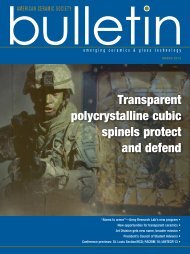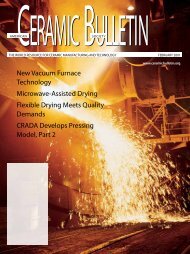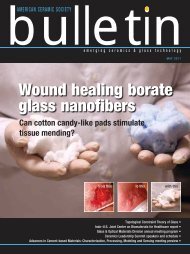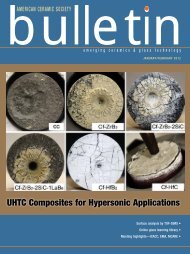AMERICAN CERAMIC SOCIETY
AMERICAN CERAMIC SOCIETY
AMERICAN CERAMIC SOCIETY
You also want an ePaper? Increase the reach of your titles
YUMPU automatically turns print PDFs into web optimized ePapers that Google loves.
ceramics in energy<br />
Simple nanoscale processes improve electrode performance in Li-ion<br />
batteries and supercapacitors<br />
Stanford University associate professor<br />
of materials science and engineering<br />
Yi Cui knows his way inside and out of<br />
a carbon nanotube, and he’s using his<br />
knowledge of that terrain to design new<br />
electrodes for lithium-ion batteries and<br />
ultracapacitors. Two papers published<br />
in recent weeks in Nano Letters describe<br />
the details.<br />
The first paper describes an approach<br />
to cathode design for Li-ion batteries<br />
that incorporates sulfur. Sulfur is an<br />
attractive cathode material because of<br />
its high storage capacity at relatively<br />
low voltage. It also is inexpensive,<br />
abundant and nontoxic. According to<br />
a Stanford news release, batteries with<br />
sulfur cathodes can store four to five<br />
times as much energy as existing Li-ion<br />
batteries.<br />
There have been previous cathode<br />
designs that coated sulfur onto porous<br />
carbon structures. However, they fail<br />
quickly during the charge–recharge<br />
cycle because intermediate lithium<br />
polysulfide compounds are in contact<br />
with the electrolyte solution and dissolve<br />
into it. Cui’s graduate student,<br />
Wesley Guangyuan Zheng, describes<br />
the problem they tackled, saying, “[W]<br />
e don’t want a large surface area contacting<br />
the sulfur and the electrolyte,<br />
and on the other hand we want a large<br />
surface area for electrical and ionic<br />
conductivities.”<br />
The Cui team separated the sulfur<br />
from the electrolyte by simply moving<br />
it inside the cathode. Adapting a<br />
commercially available water filtration<br />
process, they coated the interior of<br />
CNTs with sulfur. The new design prevents<br />
polysulfides from leaking into the<br />
electrolyte solution, while still allowing<br />
easy transport of Li ions through the<br />
CNT wall. Tests showed a high specific<br />
capacity after 150 charge–discharge<br />
cycles. In the same paper, they reported<br />
improved coulumbic efficiency gained<br />
by adding LiNO 3 to the electrolyte.<br />
American Ceramic Society Bulletin, Vol. 90, No. 9 | www.ceramics.org<br />
Cui’s second paper also investigates<br />
electrode efficiency, in this case<br />
one made with manganese dioxide, a<br />
promising material for supercapacitors<br />
(also called ultracapacitors) because of<br />
its high theoretical specific capacity,<br />
low cost and nontoxicity. However,<br />
although MnO 2 is blessed with a high<br />
charge storage capacity, it has low electrical<br />
and ionic conductivity, so getting<br />
the charge in or out quickly is a barrier.<br />
Scanning electron microscope photo of<br />
hollow carbon nanofiber-encapsulated<br />
sulfur tubes, at the heart of a new battery<br />
design.<br />
To improve the conductivity of the<br />
electrode at its surface, two conductive<br />
coatings were investigated: carbon<br />
nanotubes and a conductive polymer.<br />
Coatings were applied by dipping a<br />
graphene-MnO 2 nanostructured composite<br />
electrode into a solution of the<br />
coatings.<br />
Both coatings increased electrode<br />
conductivity, and therefore capacitance.<br />
The specific capacitance of the<br />
CNT-coated electrode increased by 25<br />
percent and that of the polymer-coated<br />
electrode increased by 45 percent. The<br />
paper also reports that the coated electrodes,<br />
which the authors describe as<br />
ternary composites, delivered superior<br />
cycling performance, retaining more<br />
than 95 percent of their capacitance<br />
after more than 3000 cycles.<br />
In a Technology Review story, it was<br />
pointed out that the energy density of<br />
(Credit: Wesley Guangyuan Zheng; Stanford Univ.)<br />
the electrode has yet to be reported.<br />
Visit www.stanford.edu/group/<br />
cui_group n<br />
Optimizing YBCO superconductor<br />
magnet design<br />
Twenty-five years after their<br />
discovery, high-temperature super- conductors<br />
are starting to be used in applications.<br />
Since the beginning, much<br />
attention has focused on the ytrrium<br />
barium copper oxide family of superconductors,<br />
and they are starting to be<br />
used in some systems. But, basic physics<br />
still presents a few obstacles.<br />
One of them is the issue of “quenching,”<br />
which is the sudden loss of the<br />
superconductive property. Quenching<br />
can be catastrophic because the sudden<br />
release of stored electricity can destroy<br />
systems. Quench protection is designed<br />
into most superconducting magnet<br />
systems, but quench onset must be<br />
detected early enough for the protection<br />
mechanism to react effectively.<br />
A difficulty yet to overcome with<br />
YBCO materials is that the “normalzone<br />
propagation velocity” is slow.<br />
The implications of this are that the<br />
property changes that signal the start of<br />
quench, such as voltage and temperature,<br />
are too small to detect.<br />
Complicating the obstacles provided<br />
by physics alone, is the challenge facing<br />
system designers to develop products<br />
based on the properties of existing<br />
materials. Device configuration can<br />
influence the quench properties, but to<br />
what extent has not been clear.<br />
A recent paper by Wan Kan Chan<br />
and Justin Schwartz at North Carolina<br />
State University introduces a way of<br />
looking at how device geometry and<br />
material selection affect the properties<br />
of a YBCO superconductor. In the news<br />
release, Schwartz says, “This approach<br />
moves us closer to the ideal of having<br />
23






